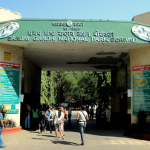Tashichho Dzong In 2024 – The Sanctuary of Governance and Spirituality
Nestled amidst the tranquil beauty of its surroundings, Tashichho Dzong in Bhutan stands as a beacon of spirituality and governance intertwined. Beyond its sacred fortress-like walls lies a place where the divine meets the earthly, where prayer and administration harmoniously coexist. Serving as both a haven for spiritual seekers and the administrative hub of our community, this monastery embodies a unique fusion of tradition and practicality.
Join us on a journey through its hallowed halls, where the whispers of ancient rituals blend with the hum of modern governance, creating a sanctuary unlike any other. So on your Bhutan tour packages, we welcome you to explore this cherished monastery, where spirituality and administration converge in a symphony of purpose and serenity.
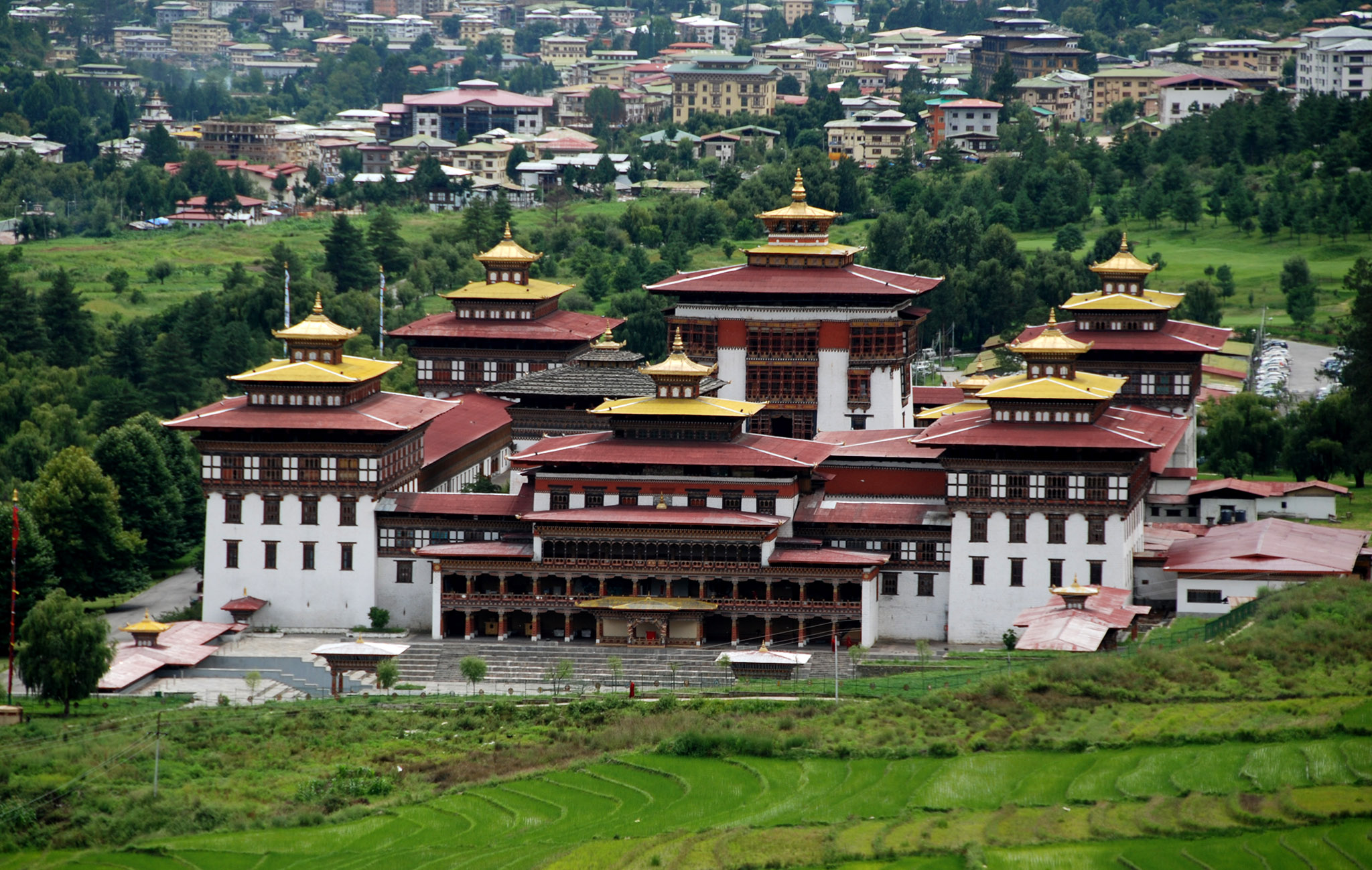
History of Tashichho Dzong
Located on the eastern bank of the Wangchu River, one of the many interesting Bhutan rivers, Tashichho Dzong Thimphu has served as the seat of the Bhutanese Government since 1952. Renowned as Thimphu Dzong, this fortress has witnessed crucial moments in Bhutanese history. Initially constructed in 1216 A.D. by Lama Gyalwa Lhanangpa, it underwent reconstruction by Zhabdrung Ngawang Namgyal in 1641, adopting its current name from Dho Ngon Dzong.
Originally comprising two dzongs, it was consolidated into the lower dzong following the destruction of the original by fire in 1771. Over time, Tashichho Dzong underwent several expansions, notably following damages from the 1897 earthquake and extensive renovations under King Jigme Dorji Wangchuck, which spanned five years starting in 1962.
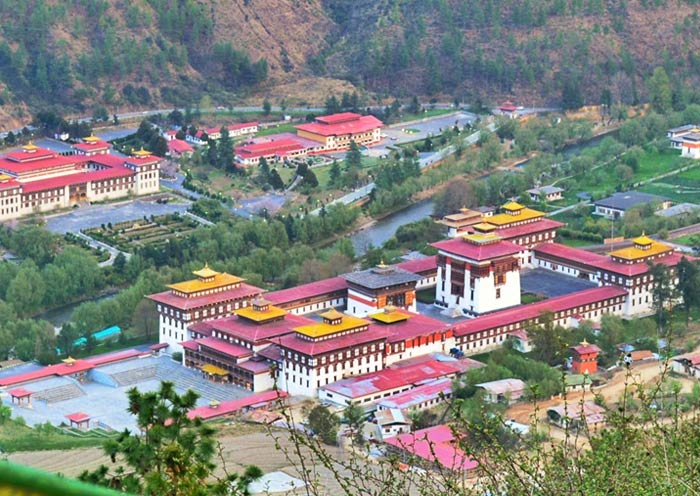
Taschichho Dzong at a glance
Tashichho Dzong now serves as the administrative building of Bhutan, housing the Throne room, the offices of the King of Bhutan, and the secretariat. Its northern section houses the central Monastic Body and serves as the summer residence for the Je Khenpo, as well as the summer capital of the nation. With 30 temples, chapels, and shrines, Tashichho Dzong is a sacred site for the Thimphu Tsechu festival. It also previously accommodated the National Assembly until 1993.
Tashichho Dzong, also known as the ‘Fortress of the Glorious Religion’ or ‘Fortress of Auspicious Doctrine’, commonly referred to as Thimphu Dzong, is a remarkable edifice. Within its walls reside the throne room, the offices of the king, the secretariat, and the ministries of home affairs and finance. Adjacent buildings accommodate additional government offices, collectively forming the administrative hub. Since 1962, when the capital shifted from Punakha to Thimphu, Tashichho Dzong has served as the seat of the Royal Government of Bhutan.
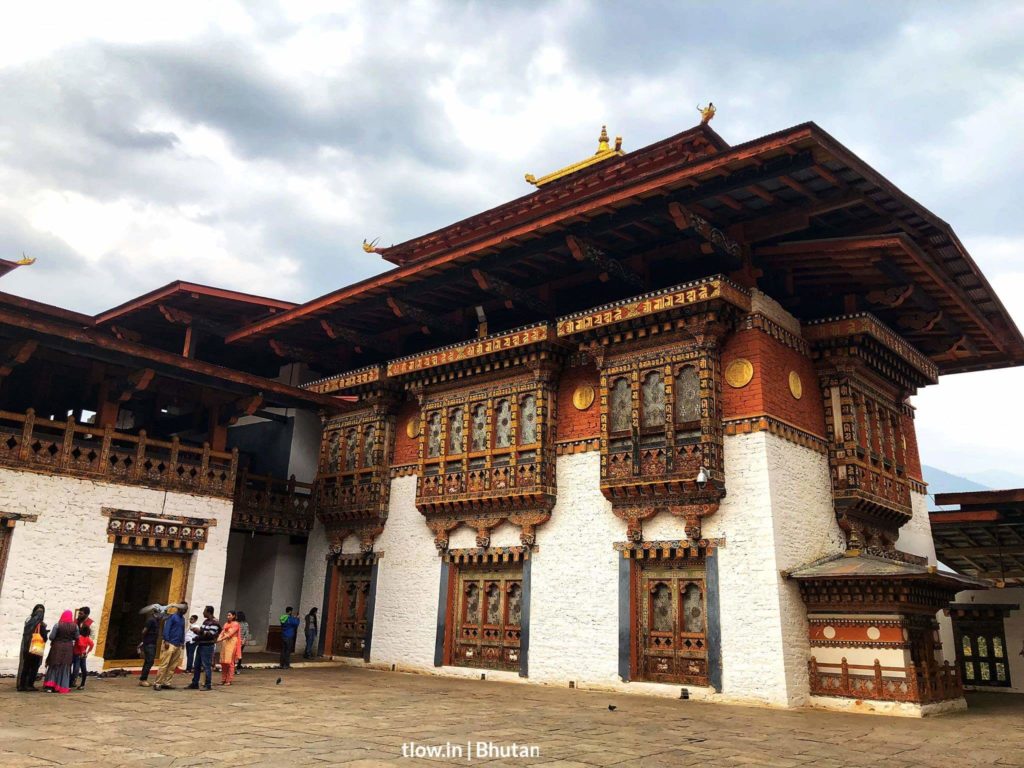
Inside the sacred halls of Tashichho Dzong
The Dzong features two entrances on its eastern side. The southeast entrance grants access to the administrative sector, while the northeast entrance leads to the monastic area. The administrative section, however, remains closed to visitors.
Upon entering from the northeastern gateway, travelers are greeted by painted figures of the four guardian kings, representing the cardinal directions. Each king is distinguished by a specific color: Vaishravana (North) in yellow, Virudhaka (South) in blue, Dhritarashtra (East) in white, and Virupaksha (West) in red.
The path to the interior of the Dzong is flanked by images of revered figures such as Drukpa Kunley, also known as the divine madman and the patron saint of Bhutan, Thang tong Gyalpo, renowned as the Iron Chair Maker for building numerous iron bridges in Bhutan, and Togden Pajo, the Buddhist master who founded the Phajoding Monastery near Thimphu.
Within the Dzong lies an assembly hall housing a magnificent statue of Sakyamuni Buddha, alongside thrones for the current and former kings, and the Je Khenpo, the Abbot of Bhutan. The ceiling is adorned with a painted Mandala, reflecting the traditional inclinations of the Bhutanese people, evident in the intricate patterns adorning the Dzongs of Bhutan. A visit to Tashichho Dzong evokes a sense of tradition, transforming the imposing structure into a living museum.
Towards the northeastern part of the Dzong stands a traditional cantilever bridge, a common feature around Bhutanese Dzongs, reflecting the country’s rich historical and architectural heritage. In 1962, extensive renovations were undertaken at the Dzong under the direction of King Jigme Dorji Wangchuk.
A meticulous five-year plan was implemented using traditional methods, with not a single nail employed in the entire structure. Once the venue for the National Assembly, the Dzong now houses the Secretariat, the throne room, and various offices related to home affairs and finance, alongside the office of the King of Bhutan.
How to Reach Tashichho Dzong
First, you need to reach Bhutan from India before moving on to Thimphu. Tashichho Dzong Bhutan rests within the city of Thimphu. The nearest airport, located 54 km away in Paro, serves as the sole international airport in Bhutan, with limited flight access. Travelers can opt for Drukair, the Royal Bhutan Airlines, offering flights from select destinations including Bangkok, Kathmandu, Singapore, Dhaka, Sydney, Kolkata, Gaya, and Bagdogra. Upon arrival at Paro Airport, transportation options include hiring a car for the journey to Thimphu.
Alternatively, travelers can arrange for private taxi services from Bagdogra Airport, NJP station, or Siliguri stand to reach Phuentsholing. From there, they can proceed to Thimphu by bus or taxi.
Tashichoo Dzong Travel tips
- Along with wandering the halls one of the things to do in Tashichho Dzong, is travel to the west of Thimphu Dzong wherein lies Ney Khang Lhakhang, a modest tower where a revered statue of Shakyamuni Buddha and various other Buddhist figures are enshrined.
- The Dzong offers an unparalleled night view, especially if you arrive after 5 pm, so consider staying until sunset to fully appreciate its beauty.
- While photography is restricted in certain areas such as the King’s offices and the temple, it’s still worth bringing your camera to capture the breathtaking scenes this Dzong has to offer.
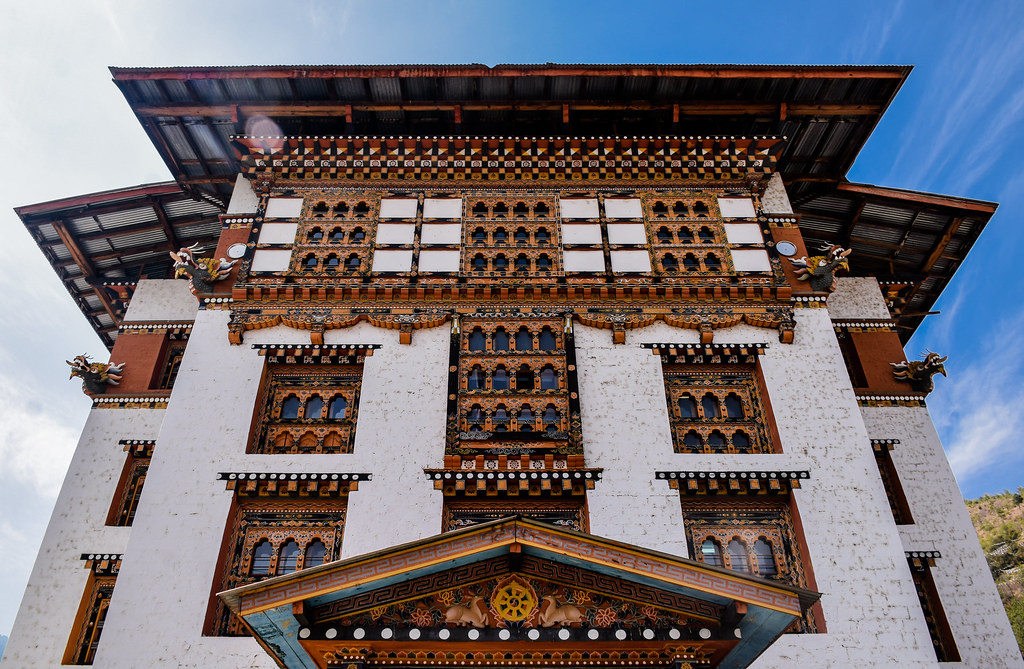
Places near Tashichho Dzong
Thimphu, Bhutan is blessed with amazing places to visit. Some of the amazing locations near Tashichho Dzong that you can visit are:
- The Royal Textile Academy of Bhutan
Near Tashichho Dzong, you’ll find the Royal Textile Academy, a must-visit for those passionate about fashion and textiles. This institution plays a vital role in preserving Bhutanese heritage by conserving traditional textiles and imparting training to ensure the continuity of this craft for future generations.
- Choki Traditional Art School
The Choki Traditional Art School is another noteworthy destination dedicated to safeguarding Bhutanese traditional arts. Here, young artists refine their skills in painting (thangkas), sculpture, and various handicrafts. A visit offers the opportunity to witness these talented artisans in action and even acquire authentic Bhutanese artwork.
- National Library of Bhutan
For bibliophiles and history enthusiasts, the National Library of Bhutan awaits. Housing a vast collection of ancient Buddhist texts and manuscripts, this institution is a treasure trove of knowledge. Yet, it’s not only the contents that make it remarkable; the building itself, designed in traditional Bhutanese style, is a sight to behold. It stands as a testament to Bhutanese history and religion, housing some of the oldest records of the nation’s heritage.
When is the best time to visit Tashichho Dzong?
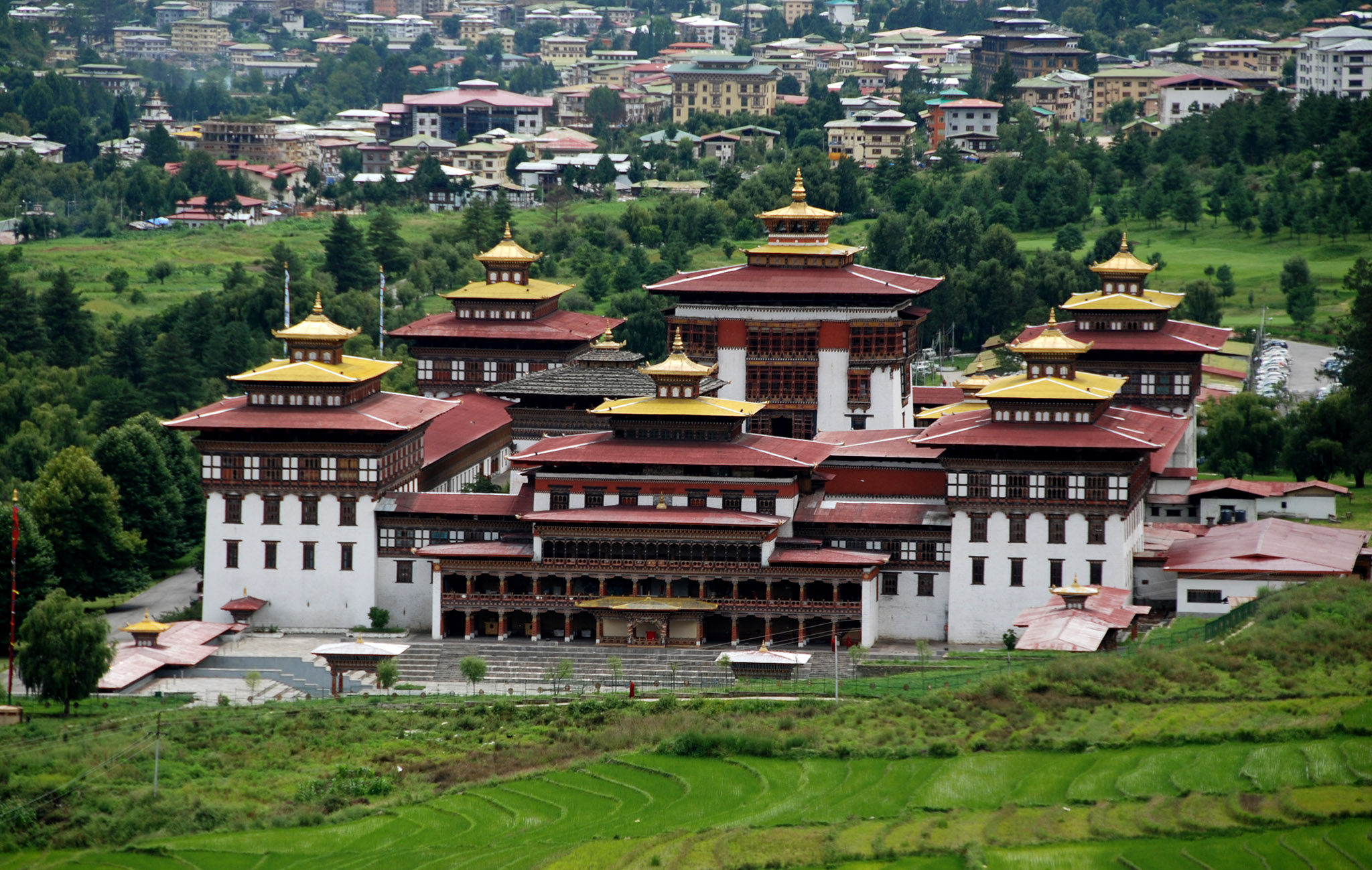
Bhutan is blessed with pleasant weather most of the year and the best time to visit Bhutan depends on what you expect on your journey from the seasonal flowers to amazing festivals.
Depending on the weather – Tashichho Dzong, commonly referred to as the fortress of the glorious religion, stands as an important symbol of Thimphu. When considering a trip to this grand Dzong, it’s essential to take into account the weather and climate. The best time to visit Tashichoo Dzong is during the spring months of March to May or in the fall from September to November
During these periods, the weather is mild and pleasant, providing an ideal environment for exploring the intricate architecture and serene courtyards of the monastery. Spring showcases vibrant blossoms against clear skies, while autumn presents a breathtaking palette of gold and russet foliage. Both seasons offer opportunities for outdoor pursuits and admiring the stunning Himalayan vistas, free from the challenges of extreme weather conditions.
Depending on festivals and cultural activities – When planning your trip, it’s important to consider the diverse cultural festivals that take place throughout Bhutan year-round. Among these, the Tsechu festival in Bhutan holds particular significance, celebrated with great enthusiasm during the autumn months. Participating in this festival offers a thrilling opportunity to witness Bhutanese traditions and Buddhist customs firsthand.
Tashichho Dzong transforms into a vibrant center of colorful masks, ancient dances, and spiritual revelries, providing visitors with an immersive cultural experience against the backdrop of this impressive fortress. Notably, the Thimphu Tsechu, typically occurring in September or October, stands out as one of the country’s largest festivals, drawing crowds of locals and tourists alike. Thus, aligning your visit with these festivities can greatly enhance your journey.
All things considered, for many travelers and tourists the best time to visit Tashichho Dzong Bhutan is generally regarded as March to April when the valley enveloping the Dzong bursts into a vibrant display of blooming rhododendrons, and autumn in Bhutan which is October to November, characterized by clear skies
Interesting facts about Tashichho Dzong
- In Kagawa, Shikoku, Japan, a replica of the original Tashichho Dzong can be discovered. Situated in Maragume, it is located amidst the Ayauta Forest, adjacent to the New Reoma World complex. Within this replica, visitors can explore Bhutanese artifacts and gain insights into the Kingdom through informative displays.
- In the 11th century, numerous Dzongs were constructed in Tibet and Bhutan to serve logistical purposes, while also doubling as citadels designed to provide refuge for civilians during times of conflict or natural disasters.
- An interesting and noteworthy face about Tashichho Dzong is that Bhutanese individuals, whether visiting for official duties or leisure, are expected to wear traditional attire known as Gho with Kabney for men and Kira with Rachu for women. This dress code serves as a symbolic gesture of respect. However, tourists and other visitors are also required to adhere to appropriate attire when entering the Dzong.
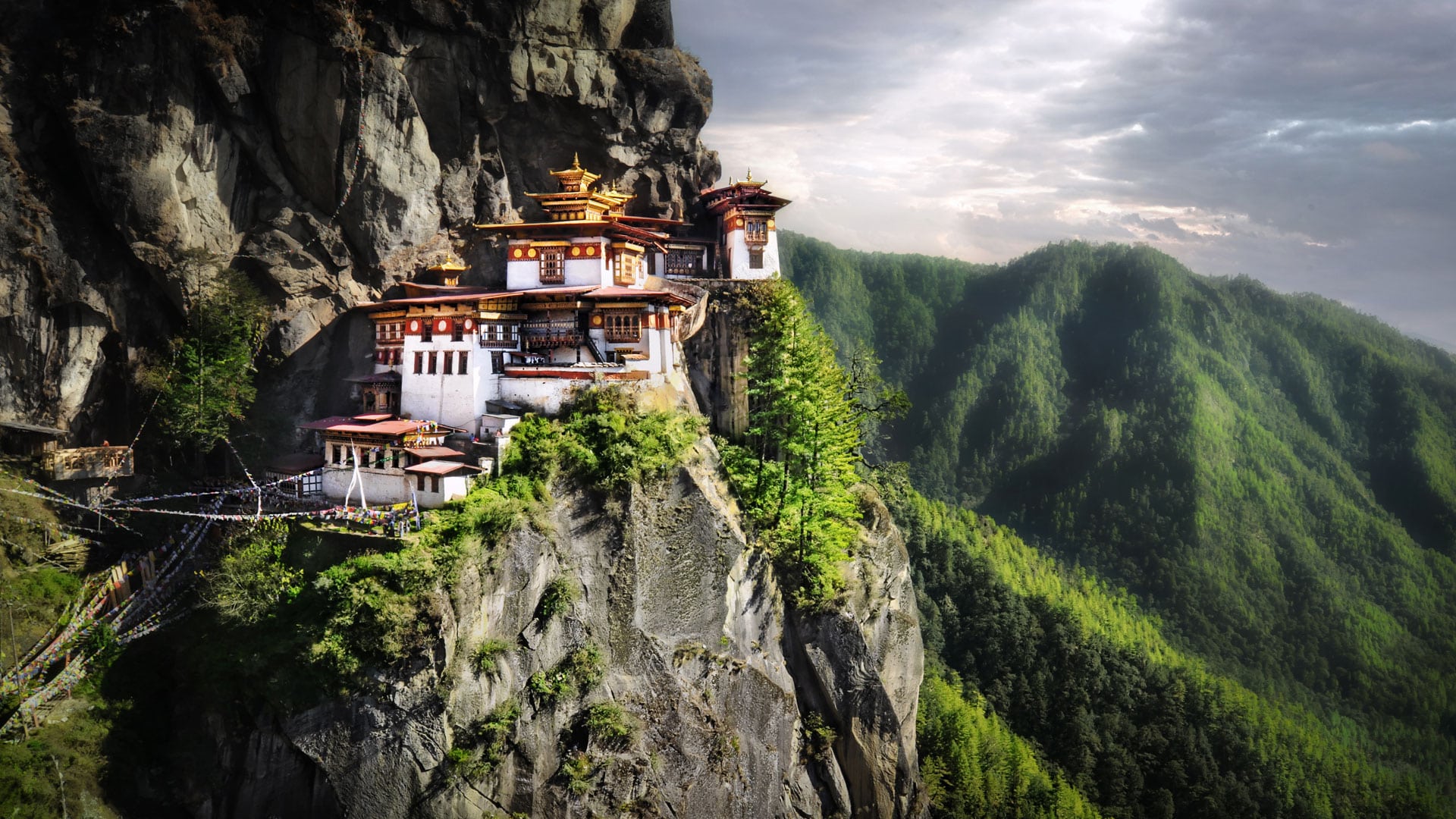
Thimphu’s Blissful Fortress and Beyond
After cherishing all those beautiful moments in Tashichho dzong, the echoes of tranquility and reverence of this sacred place leave a lingering sensation in your heart. Whether you are backpacking in Bhutan, or just here to witness historical monuments you can seek solace, enlightenment, or simply a moment of respite as Bhutan always leaves you with everlasting impressions.Like many other great monuments in Bhutan such as the Tigers Nest and the Dochula Pass, Tashichho Dzong is one of the testaments that is a must-visit place while in Thimphu.
What is Tashichho Dzong?
Tashichho Dzong is a Buddhist monastery and fortress that rests on the western bank of the flowing Wang Chhu River. Situated in the northern region of Thimphu, Bhutan’s capital city, the original Thimphu Dzong was constructed in 1216 A.D. This initial structure occupied the site where the Dechen Phodrang now stands. In 1641, Shabdrung Ngawang Namgyal assumed control of the dzong from the Lhapa Kagyu lineage, renaming it Tashichho Dzong. Subsequently, it became the principal seat of the Southern Drukpa Kagyu tradition and served as the monastic body’s summer residence. The term “Tashichho” translates to “fortress of auspicious doctrine” in the Bhutanese language.
What is the significance of Tashichho Dzong?
Tashichö Dzong has served as Bhutan’s governmental headquarters since 1968. Today, it accommodates the throne room, along with the offices of the king, the cabinet secretariat, and the ministries of home affairs and finance.
Can visitors tour Tashichho Dzong?
Yes, visitors can tour the Tashichho Dzong but only after 5 pm once the offices have shut down for the day.
When is the best time to visit Tashichho Dzong?
The best time to visit Tashichho Dzong is from March to April and October to November.





